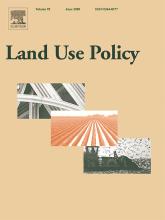Resource information
The environmental consequences of the decision to urbanise and displace peri-urban (PU) food production are not typically evaluated within a comprehensive, cross-sectoral approach. Using a novel application of life cycle assessment (LCA) within exploratory scenarios, a method for integrating housing and food production land uses in PU regions is proposed, based on relative environmental impacts. Using two housing types (greenfield and infill) and two types of food production (field and high-technology greenhouse (HTG) lettuce production), environmental impacts for five exploratory land-use scenarios are compared for PU land in a developed and growing city. Each scenario is able to house an equivalent residential population whilst delivering equal quantities of fresh food to a city market. The results clearly indicate that infill housing and food production has less environmental impact than greenfield development. The environmental impact categories of climate change, freshwater eutrophication, photochemical oxidant formation, particulate matter formation and human toxicity are reduced by 25–43 percent under infill scenarios. Sparing PU land through infill housing development combined with sustainable food intensification using HTG production, enabled multifunctional PU land-use including food production, housing and afforestation while delivering lower relative environmental impacts. Urban afforestation on PU land made available by these measures reduces the effect of climate change by up to 5 percent per hectare per year.


